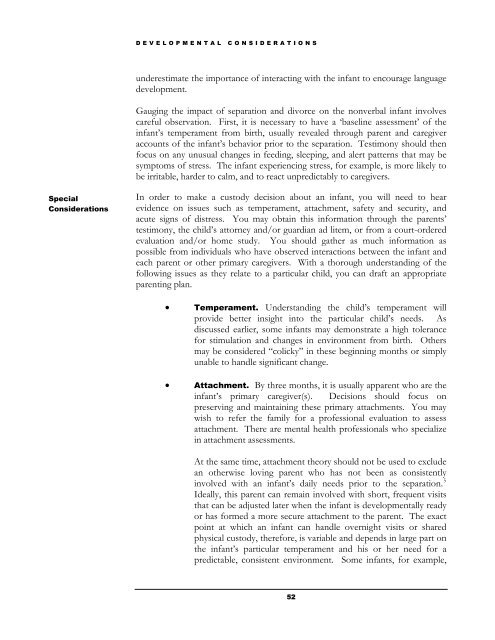A Judge’s Guide
A Judge’s Guide
A Judge’s Guide
You also want an ePaper? Increase the reach of your titles
YUMPU automatically turns print PDFs into web optimized ePapers that Google loves.
Special<br />
Considerations<br />
DEVELOPMENTAL CONSIDERATIONS<br />
underestimate the importance of interacting with the infant to encourage language<br />
development.<br />
Gauging the impact of separation and divorce on the nonverbal infant involves<br />
careful observation. First, it is necessary to have a ‘baseline assessment’ of the<br />
infant’s temperament from birth, usually revealed through parent and caregiver<br />
accounts of the infant’s behavior prior to the separation. Testimony should then<br />
focus on any unusual changes in feeding, sleeping, and alert patterns that may be<br />
symptoms of stress. The infant experiencing stress, for example, is more likely to<br />
be irritable, harder to calm, and to react unpredictably to caregivers.<br />
In order to make a custody decision about an infant, you will need to hear<br />
evidence on issues such as temperament, attachment, safety and security, and<br />
acute signs of distress. You may obtain this information through the parents’<br />
testimony, the child’s attorney and/or guardian ad litem, or from a court-ordered<br />
evaluation and/or home study. You should gather as much information as<br />
possible from individuals who have observed interactions between the infant and<br />
each parent or other primary caregivers. With a thorough understanding of the<br />
following issues as they relate to a particular child, you can draft an appropriate<br />
parenting plan.<br />
Temperament. Understanding the child’s temperament will<br />
provide better insight into the particular child’s needs. As<br />
discussed earlier, some infants may demonstrate a high tolerance<br />
for stimulation and changes in environment from birth. Others<br />
may be considered “colicky” in these beginning months or simply<br />
unable to handle significant change.<br />
Attachment. By three months, it is usually apparent who are the<br />
infant’s primary caregiver(s). Decisions should focus on<br />
preserving and maintaining these primary attachments. You may<br />
wish to refer the family for a professional evaluation to assess<br />
attachment. There are mental health professionals who specialize<br />
in attachment assessments.<br />
At the same time, attachment theory should not be used to exclude<br />
an otherwise loving parent who has not been as consistently<br />
involved with an infant’s daily needs prior to the separation. 5<br />
Ideally, this parent can remain involved with short, frequent visits<br />
that can be adjusted later when the infant is developmentally ready<br />
or has formed a more secure attachment to the parent. The exact<br />
point at which an infant can handle overnight visits or shared<br />
physical custody, therefore, is variable and depends in large part on<br />
the infant’s particular temperament and his or her need for a<br />
predictable, consistent environment. Some infants, for example,<br />
52


